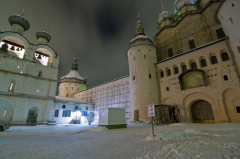
I got my idea of how to weave lace from the magazine… “Young Technician.” At some point in the history of this popular magazine (in the mid-1970s), the editors began publishing materials on various types of folk crafts—with brief histories, descriptions of techniques, photographs, and diagrams.
Cloisonné enamel, carpet weaving, basket weaving, macrame, wood carving… Among other things, this very lace, made on a pin-studded roller, was on display. This was real lace, woven—not just ordinary crochet.
The technique, in brief, is as follows. The work is done using bobbins on a roller (a cylindrical cushion), which must be packed very tightly, and the roller is placed on a stand.
Bobbins are decorative sticks with necks. They are the basic tool for lace weaving; threads are wound around pairs of these bobbins. When the bobbins are tossed, the threads intertwine, creating a pattern.
The areas needed for weaving are pinned to the pillow using a special pattern. The pins required are special (never the old “Soviet” kind, with a looped eye to catch the thread). The pins have a ball-shaped head to prevent pricking the finger. The special pattern isn't held in the lacemaker's mind, but is a schematic drawing, a pattern pinned to the pillow.
The general information was imprinted in the depths of my memory, to be recalled decades later while exploring the exhibition “Russian Lace Pieces from the Museums of Rostov and Vologda.”
Of course, that old “Young Technician” magazine was specifically about Vologda lace. The roller, bobbins, and pliers—these “tools” are still in use by Vologda lacemakers. The general public was unaware of all the other lacemaking centers (Torzhok, Yelets, Rostov the Great, Kalyazin, Ryazan, and so on), but Vologda lace, which had survived into Soviet times, was well-known.
In Vologda, lacemakers were trained not in small workshops but in vocational schools. The industry there is still alive and well, and its products are in demand. All other lacemaking centers are mostly considered abandoned, and only a few enthusiasts attempt to reproduce ancient lace from museum exhibits.
The fruits of their labor are displayed in art galleries and featured at specialized exhibitions. But what's missing from these exhibitions are chipped works!
A piece of lace
A pattern, as mentioned above, is a lace drawing. It's not even a drawing, but a blueprint, a process chart. It contains, firstly, the outline of the future lace, secondly, a weaving pattern, and thirdly, it indicates where the pins should be placed during weaving.
Lace made from a pattern (see fig. 1)
The fragment became the subject of a museum exhibition for the first time in Russia in March 2009, at the Rostov Kremlin Museum-Reserve. Why was this museum the right place to hold such an exhibition?
The museum owed this opportunity to Ya.N. Shchapov, Doctor of Historical Sciences and Corresponding Member of the Russian Academy of Sciences. The Shchapovs were an old Rostov merchant family, and members of the Shchapov family owned several houses in Rostov the Great.
The family archive contains a magnificent collection of fragments, which Yaroslav Nikolaevich donated to the Rostov Museum in 2008. These fragments are dated and date back to the first half of the 19th century.
Yaroslav Nikolaevich Shchapov
Ya. N. Shchapov's gift immediately made the Rostov Museum the owner of the largest collection of chipped stones in Russia. Experts note the uniqueness of this collection. The pieces are in excellent condition and are “original”—their owners, Rostov craftswomen V. I. Gogina and A. F. Ponomareva, are known.
Vologda colleagues are positively envious of Rostov museum workers: the Vologda Museum also has chips, but they are much more recent and in poor condition. And it's understandable why—for Vologda craftswomen, chips have been and remain a tool of their trade; they are, as they say, in use, constantly in use.
Since the material used to make the chip is, in the vast majority of cases, paper, it's clear that the lifespan of the “technological chart” is short. With frequent use, the chips tend to split: repeated pinning enlarges the holes, and the clarity of the design is lost. Therefore, craftswomen are forced to periodically re-glue, or even re-create, the chips. And anything more or less suitable is used for re-gluing.
For example, in the 19th century, a very suitable material was… thick stamped paper, on which various documents were written. Or – also fairly thick wrapping paper. Or – used children's exercise books. These are what Vologda skolki are like – strips of paper glued and stitched together from documents from different periods. Craftswomen also contributed to the skolki's “design” – they left notes on them, either of a production nature (explanations on lace weaving) or of a more mundane nature – similar to what scribes used to do in the margins of manuscripts.
But let's return to the Rostov collection. The fragments are in excellent condition—not chipped. They are dated, original pieces, used infrequently, by only one craftswoman—the owner herself. Incidentally, this also suggests that the lacemaking done by Rostov craftswomen was, as they say, non-commercial. They wove to adorn the clothes of themselves and their loved ones.
Paintings from the art gallery of the Rostov Kremlin Museum provide an idea of what such jewelry looked like on Rostov merchant women. For example, a portrait of E. I. Kaidalova, painted by an unknown artist in the 1830s (the same period as the Rostov collection of fragments).
Portrait of E.I. Kaidalova from the Rostov Kremlin collection
When Ya. N. Shchapov donated the collection to the museum, he completed a description of it. One of the conditions of the donation was the mandatory publication of a catalogue.
Album-catalogue of the collection of chips
At the end of 2009, this condition was fulfilled, and the well-published catalog “Rostov Antique Lace Pieces from the Shchapov Collection” (authors E. V. Bryukhanova and Ya. N. Shchapov) was published. This catalog immediately became an object of desire not only for museum specialists in fabrics and lace, but also, to a greater extent, for contemporary lacemakers.
Under the guidance of renowned researcher of traditional Russian lace, I. E. Belozerova, these craftswomen have already attempted to reproduce traditional Rostov lace. It turned out to be quite difficult—these patterns weren't designed for modern, factory-made threads.
It turns out that the ancient fragments require a reconstruction of the entire production cycle—from raw material acquisition to hand spinning. Doesn't this refrain, dear reader, come alive in your memory: “In a low room / A light burns, / A young spinner / Sits by the window…” Besides reflections on a girl's lot and a dear friend, the song also contains instructions on spinning technology: “You must spin so tightly, / Don't break the thread, / Love and never forget your dear friend!”
It's difficult to judge how reproducible the process is in all its details. The main thing is that a craft that until recently was little known, a craft that had died out, has suddenly become fully visible to specialists and connoisseurs.





